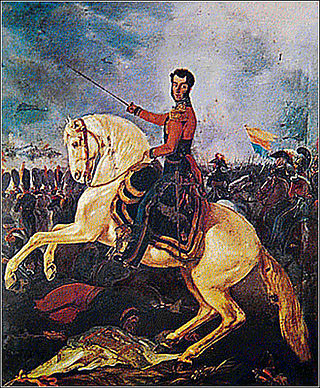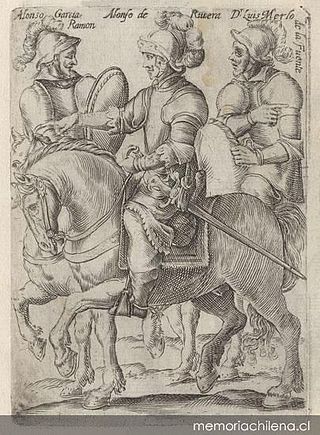
The Bolivian war of independence began in 1809 with the establishment of government juntas in Sucre and La Paz, after the Chuquisaca Revolution and La Paz revolution. These Juntas were defeated shortly after, and the cities fell again under Spanish control. The May Revolution of 1810 ousted the viceroy in Buenos Aires, which established its own junta. Buenos Aires sent three large military expeditions to Upper Peru, headed by Juan José Castelli, Manuel Belgrano and José Rondeau, but the royalists ultimately prevailed over each one. However, the conflict grew into a guerrilla war, the War of the Republiquetas, preventing the royalists from strengthening their presence. After Simón Bolívar and Antonio José de Sucre defeated the royalists in northern South America, Sucre led a campaign that was to defeat the royalists in Charcas for good when the last royalist general, Pedro Antonio Olañeta, suffered death and defeat at the hands of his own defected forces at the Battle of Tumusla. Bolivian independence was proclaimed on 6 August 1825.
A Real Audiencia, or simply an Audiencia, was an appellate court in Spain and its empire. The name of the institution literally translates as Royal Audience. The additional designation chancillería was applied to the appellate courts in early modern Spain. Each audiencia had oidores.

Nuño Beltrán de Guzmán was a Spanish conquistador and colonial administrator in New Spain. He was the governor of the province of Pánuco from 1525 to 1533 and of Nueva Galicia from 1529 to 1534, and president of the first Royal Audiencia of Mexico – the high court that governed New Spain – from 1528 to 1530. He founded several cities in Northwestern Mexico, including Guadalajara.

The Ecuadorian–Peruvian territorial dispute was a territorial dispute between Ecuador and Peru, which, until 1928, also included Colombia. The dispute had its origins on each country's interpretation of what Real Cedulas Spain used to precisely define its colonial territories in the Americas. After independence, all of Spain's colonial territories signed and agreed to proclaim their limits in the basis of the principle of uti possidetis juris, which regarded the Spanish borders of 1810 as the borders of the new republics. However, conflicting claims and disagreements between the newly formed countries eventually escalated to the point of armed conflicts on several occasions.

Melchor Bravo de Saravia y Sotomayor was a Spanish conquistador, interim viceroy of Peru, and Royal Governor of Chile.

The Spanish East Indies were the overseas territories of the Spanish Empire in Asia and Oceania from 1565 to 1898, governed for the Spanish Crown from Mexico City and Madrid through the captaincy general which ruled Manila.

The Royal Audiencia of Santiago was an Audiencia Real or royal law court that functioned in Santiago de Chile during the Spanish colonial period. This body heard both civil and criminal cases. It was founded during the 17th century and abolished in 1817.

Luis Merlo de la Fuente Ruiz de Beteta was a Spanish colonial official who briefly served as the Royal Governor of Chile, in 1610–11.
Francisco Ceinos was one of five oidores (judges) of the second Real Audiencia of Mexico. This group governed the colonies of New Spain from January 10, 1515 to April 16, 1535. Ceinos was also president of the audiencias that served as interim governments of New Spain from 1564 to 1566 and from approximately July 1568 to November of that year.
The Real Audiencia of Charcas was a Spanish audiencia with its seat in what is today Bolivia. It was established in 1559 in Ciudad de la Plata de Nuevo Toledo and had jurisdiction over Charcas, Paraguay and the Governorate of the Río de la Plata, today Uruguay and northern Argentina. This court oversaw the incredible silver output of the mines at Potosí. It was part of the Viceroyalty of Peru until 1776, when it was transferred to the newly created Viceroyalty of the Río de la Plata and began to be referred to as Upper Peru.

The Captaincy General of Venezuela, also known as the Kingdom of Venezuela, was an administrative district of colonial Spain, created on September 8, 1777, through the Royal Decree of Graces of 1777, to provide more autonomy for the provinces of Venezuela, previously under the jurisdiction of the Audiencia of Santo Domingo and then the Viceroyalty of New Granada. It established a unified government in political (governorship), military, fiscal (intendancy), ecclesiastical (archdiocese) and judicial (audiencia) affairs. Its creation was part of the Bourbon Reforms and laid the groundwork for the future nation of Venezuela, in particular by orienting the province of Maracaibo towards the province of Caracas.

The New Kingdom of Granada, or Kingdom of the New Granada, was the name given to a group of 16th-century Spanish colonial provinces in northern South America governed by the president of the Royal Audience of Santafé, an area corresponding mainly to modern-day Colombia. The conquistadors originally organized it as a province with a Royal Audience within the Viceroyalty of Peru despite certain independence from it. The audiencia was established by the crown in 1549. Ultimately the kingdom became the Viceroyalty of New Granada first in 1717 and permanently in 1739. After several attempts to set up independent states in the 1810s, the kingdom and the viceroyalty ceased to exist altogether in 1819 with the establishment of the United Provinces of New Granada.

The Real Audiencia of Quito was an administrative unit in the Spanish Empire which had political, military, and religious jurisdiction over territories that today include Ecuador, parts of northern Peru, parts of southern Colombia and parts of northern Brazil. It was created by Royal Decree on 29 August 1563 by Philip II of Spain in the city of Guadalajara. It ended in 1822 with the incorporation of the area into the Republic of Gran Colombia.
The Real Audiencia of Mexico or Royal Audiencia of Mexico was the highest tribunal of the Spanish crown in the Kingdom of New Spain. The Audiencia was created by royal decree on December 13, 1527, and was seated in the viceregal capital of Mexico City. The First Audiencia was dissolved by the crown for its bungling and corruption and the crown established the Second Audiencia in 1530. This was supplanted by the Viceroyalty of New Spain in 1535. A new Audiencia was created in Guadalajara in western Mexico in 1548.
The Real Audiencia of Guadalajara, was the highest tribunal of the Spanish crown in what is today northern Mexico and the southwestern United States in the Viceroyalty of New Spain. It was created by royal decree on February 13, 1548, and was originally located in Compostela and permanently seated in Guadalajara in 1560. Its president was the chief political and executive officer of the district, subordinated only to the Viceroy.
The Real Audiencia of Manila was the Real Audiencia of the Spanish East Indies, which included modern-day Guam, the Northern Mariana Islands, Palau, Micronesia and the Philippines. Similar to Real Audiencias throughout the Spanish Empire, it was the highest tribunal within the territories of the Captaincy General of the Philippines, a dependency of the Viceroyalty of New Spain.

An oidor was a judge of the Royal Audiencias and Chancillerías, originally courts of Kingdom of Castile, which became the highest organs of justice within the Spanish Empire. The term comes from the verb oír, "to hear," referring to the judge's obligation to listen to the parts of a judicial process, particularly during the phase of pleas.
The Real Audiencia and Chancery of Lima was a superior court in the New World empire of Spain, located in the city of Lima, capital of the Viceroyalty of Peru. It was created on November 20, 1542 as was the viceroyalty itself, by the Emperor Charles V. The Audiencia began functioning in 1543 and initially had jurisdiction over the entire viceroyalty—virtually all of Spanish-controlled South America and Panama. Later other audiencias were established in the Viceroyalty. The Audiencia functioned until 1821 when the forces of José de San Martín entered Lima.
The Royal Audience and Chancery of Panama in Tierra Firme was a governing body and superior court in the New World empire of Spain. The Audiencia of Panama was the third American audiencia after the ones of Santo Domingo and Mexico. It existed three times under various guises since it first creation in 1538 until its ultimate abolition in 1751.
The Real Audiencia of Santiago de Guatemala, simply known as the Audiencia of Guatemala or the Audiencia of Los Confines, was a Real Audiencia in the Imperial Spanish territory in Central America known as the Captaincy General of Guatemala (1609-1821). The Audiencia's presiding officer, the president, was the head of the government of the area. The Audiencia was initially created by decrees of November 20, 1542 and September 13, 1543, and had its seat in Antigua Guatemala.